Invasive Meningococcal Disease (IMD):
IMD is an uncommon but fast-onset and potentially life-threatening illness, with similar clinical presentation regardless of the causal serogroup.1
One IMD: One disease regardless of serogroup
IMD is an uncommon but unpredictable disease caused by Neisseria meningitidis that can lead to death or have severe and long-term consequences for survivors and their caregivers, even when diagnosed early and appropriate treatment is administered.1,2
IMD is rare, but peaks in incidence in infants, adolescents, and older adults.3
Clinical presentation of IMD, disease course, and consequences are similar, regardless of the causal serogroup. Almost all IMD is caused by serogroups A, B, C, W and Y. In the US, serogroup B is the leading cause in adolescents and accounts for roughly half of all IMD cases in that age group. 1,4–7
There are vaccines available to help protect against the 5 disease-causing IMD serogroups: A, B, C, W, and Y.8

Unmet needs in Invasive Meningococcal Disease
Disease overview
20%
Of individuals with IMD can have severe long-term outcomes
One in ten IMD cases may result in death, and up to 20% of individuals with IMD can experience serious long-term consequences.1,2
Learn more
Meningococcal vaccines for 5 disease-causing serogroups
Up to 87%
Of adolescents remain unvaccinated against 1 or more of these 5 serogroups.4,9
Awareness gaps hinder full vaccination coverage, leaving adolescents vulnerable.4 HCP recommendations greatly influence vaccination decisions.4
Learn more
Helping to protect adolescents and young adults against IMD
54%
Of young adults agreed that vaccination was the best way to help protect against IMD.10
A 2022 online survey of 606 US-based young adults and parents of older adolescents, showed a high interest in learning about IMD.10,11
Learn more
Learn more about Invasive Meningococcal Disease
Disease overview
Did you know? Many survivors of IMD described transitioning from healthy or normal lives to becoming medically fragile and losing independence. Their caregivers experienced distress and impacts on their careers.12 Healthcare providers play an important role in sharing information to help prevent this potentially life-threatening disease. Talk to all of your adolescent and young adult patients about getting vaccinated against IMD.4,5,9
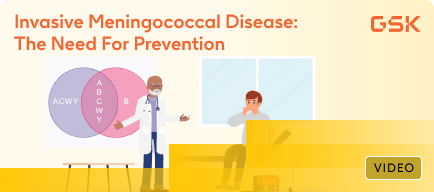
IMD Prevention
- Video
- • 6:09

Meet John, IMD Survivor
- Video
- • 5:40

Meet Allison, Keegan’s Mom
- Video
- • 7:37

Meet Dr. Amit Rawal, Emergency Medicine Physician
- Video
- • 5:52
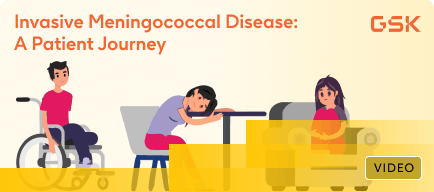
IMD Patient Journey
- Video
- • 6:09
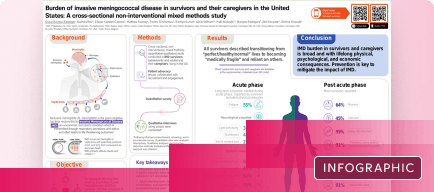
Burden of IMD in survivors and their caregivers
- Infographic

Meningococcal Epidemiology and Disease Overview
- Presentation
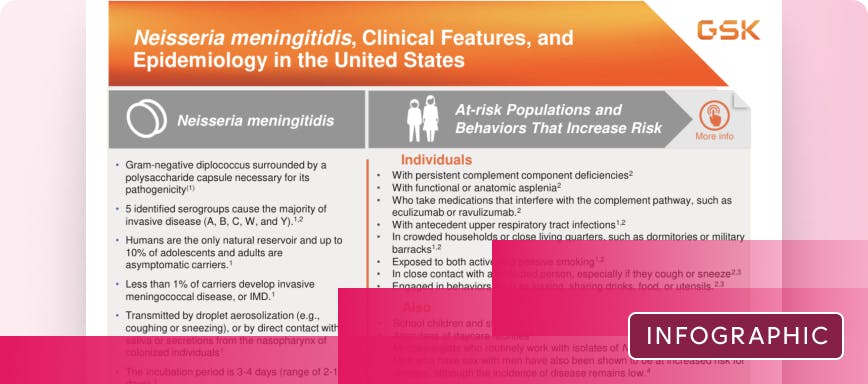
Neisseria Menigitidis disease epidemiology in the US
- Infographic
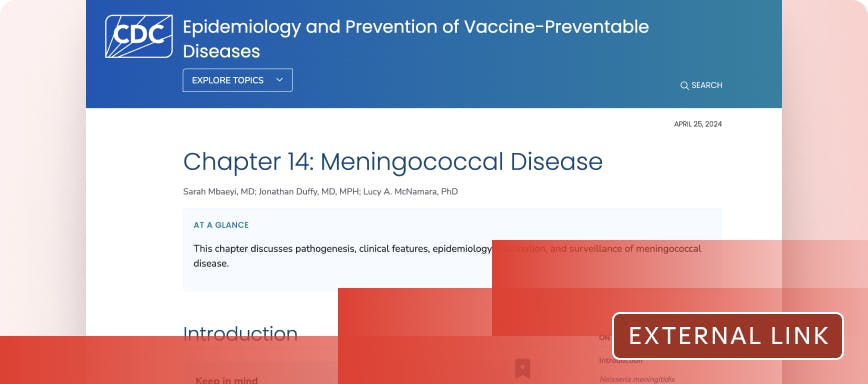
The pink book: Epidemiology and Prevention of meningococcal disease
- Link

Invasive Meningococcal Disease
- Video
- • 6:09
Meningococcal vaccines against 5 serogroups
Did you know? Different types of vaccines are available to help protect against 5 disease-causing serogroups.4,13
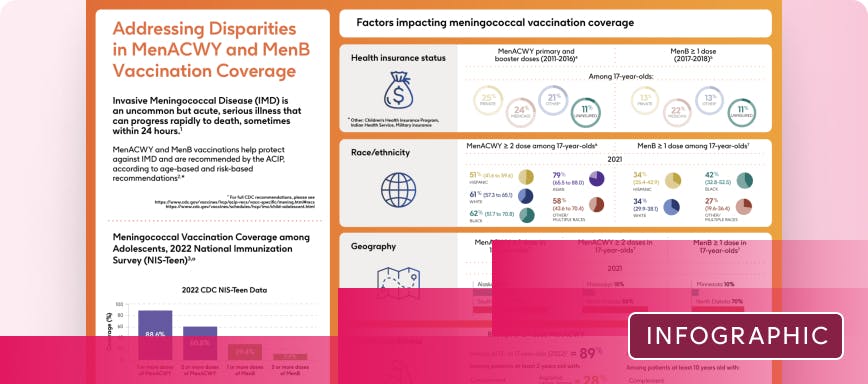
Addressing disparities in MenACWY and MenB Vaccination Coverage
- Infographic
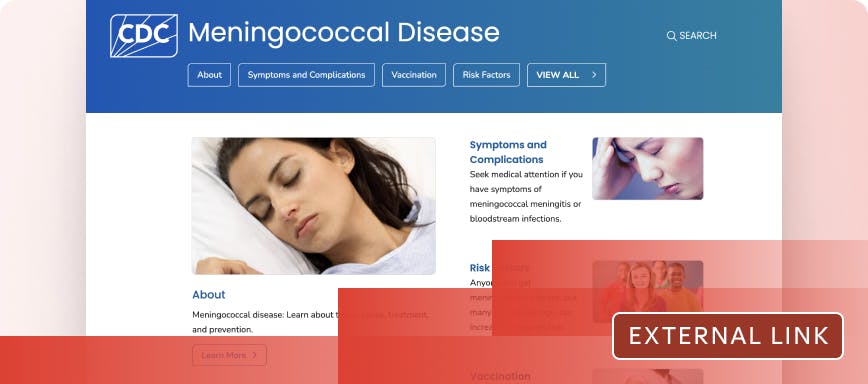
CDC Meningococcal Information
- Link
Protecting adolescents and young adults against IMD
Did you know? A lack of recommendation or mention of MenB vaccination from their healthcare provider was often reported as a barrier by parents of non-vaccinated adolescents and young adults.4,10
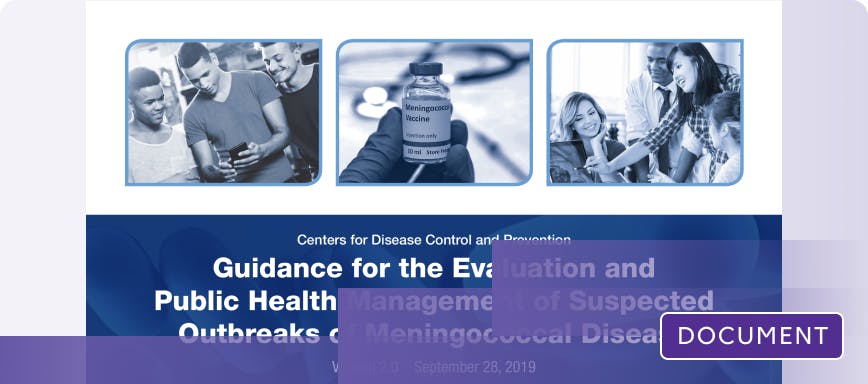
Guidance for the Evaluation and Public Health Management of Suspected Outbreaks of Meningococcal Disease
- Document
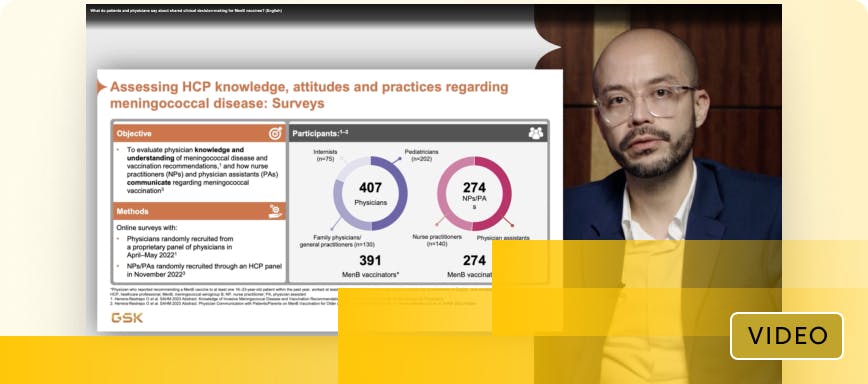
What do patients and physicians says about SCDM for MenB vaccines?
- Video
- • 10:51

What do patients and physicians says about SCDM for MenB vaccines? (Spanish)
- Video
- • 12:49
References
- CDC. Manual for the Surveillance of Vaccine-Preventable Diseases. Chapter 8: Meningococcal Disease. Rubis A, Schilie S. Last reviewed October 30, 2024. Accessed November 06, 2024. Link

- Thompson MJ, et al. Lancet. 2006;367(9508):397–403. Link

- CDC. Meningococcal Disease Surveillance and Trends. Last reviewed November 12, 2024. Accessed November 06, 2024. Link

- Herrera-Restrepo O, et al. J Nurse Pract. 2024;20:1104793. Link

- Herrera-Restrepo O, et al. J Adolesc Health. 2023;74(6):1131–1138. Link

- CDC. Enhanced Meningococcal Disease Surveillance Report, 2022. Accessed October 11, 2024. Link

- Rubis A. ACIP presentation, June 28, 2024. Accessed December 18, 2024. Link

- CDC. Meningococcal Vaccine Recommendations. Last reviewed October 24, 2024. Accessed November 06, 2024. Link

- Pingali C, et al. MMWR Morb Mortal Wkly Rep. 2023;72(34):912–919. Link

- Herrera_Restrepo O, et al. Curr Med Res Opin. 2024;40:125–140. Link

- Herrera-Restrepo O, et al. Curr Med Res Opin. 2024;40:1071–1074. Link

- Herrera-Restrepo O, et al. Infect Dis Ther. 2024; Dec;13(12):2563–2579. Link

- CDC. Recommended Child and Adolescent Immunization Schedule for ages 18 years or younger. Accessed October 11, 2024. Link




